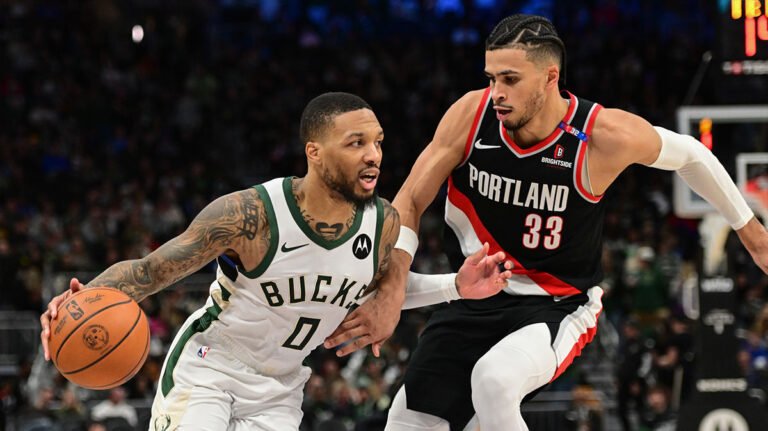NBA News: Why Damian Lillard Didn’t Shed Tears After Bucks’ Torn Achilles Diagnosis — “Portland Changed Me”…see more…
Milwaukee Bucks star Damian Lillard is no stranger to emotional battles on and off the court. But when news broke of his teammate’s devastating torn Achilles injury during a routine practice session earlier this month, many were surprised by Lillard’s stoic response. While sympathy and concern poured in from players around the league, Lillard stood calm — composed, yet not visibly shaken. Now, the veteran guard is opening up about why he didn’t cry, and how years in Portland changed his emotional compass.
The incident unfolded at the Bucks’ training facility, where a scrimmage abruptly ended after one of the team’s young rising players collapsed in agony. Though the Bucks have not officially confirmed the player’s identity due to medical privacy, multiple reports point to MarJon Beauchamp as the one who suffered a full tear of the Achilles tendon. The injury is expected to sideline him for the entire 2025–26 NBA season, dealing a major blow to Milwaukee’s depth.
Lillard, who joined the Bucks in a blockbuster trade from the Portland Trail Blazers in 2023, immediately became a leader in the locker room. He’s long been praised for his loyalty, maturity, and leadership — qualities that made him the face of the Blazers for over a decade. However, he now admits that his emotional tone has shifted significantly since his time in the Pacific Northwest.
“People expect you to cry or break down when things like this happen,” Lillard said in a sit-down interview with The Athletic. “But I’ve seen so much over the years — injuries, betrayals, trades, people coming and going — Portland hardened me. Not in a bad way. It made me emotionally smarter.”
Indeed, Lillard’s time with the Trail Blazers was marked by a mix of brilliant performances and organizational frustration. He spent 11 seasons with Portland, delivering highlight-reel moments, deep playoff runs, and All-Star caliber play. Yet, the franchise’s inability to surround him with championship-level talent gradually wore on him.
“It’s not that I don’t care,” Lillard clarified. “When you’ve been in the game as long as I have, you learn to internalize things differently. I went through seasons where teammates got traded mid-game, where the guys I went to war with were gone the next morning. It teaches you not to react outwardly every time something bad happens.”
The 34-year-old point guard emphasized that his response was about resilience, not detachment. “I talked to [the injured player] that night. Told him I’ve seen guys come back from this. KD did it. Klay did it. He can too. That’s what matters now — showing up, being real, and pushing forward.”
NBA players and fans are no strangers to Achilles injuries and the brutal toll they take on athletic careers. Kevin Durant missed the entire 2019–20 season after suffering an Achilles tear during the NBA Finals. Klay Thompson suffered the same fate and endured multiple years of rehab. Though modern sports medicine has evolved, Achilles injuries remain among the most difficult to recover from.
Lillard’s perspective is perhaps best viewed through the lens of his personal journey — a career defined by unrelenting commitment to growth and leadership. “I’ve cried a lot in this league, man,” he said. “Losses, deaths, family stuff, betrayal. You don’t forget how to feel. You just choose how to process it. You get to a place where you don’t panic, don’t break. You just keep moving.”
When asked whether he believed his time in Portland made him colder or just wiser, Lillard paused. “I think it made me clearer. You see the game, the business, the human side of it all. That kind of clarity comes with a cost.”
Lillard’s comments reflect a growing understanding among veteran athletes of the need for mental strength and emotional control. In a high-pressure sport where rosters are fluid and careers can change in an instant, players are often forced to adapt emotionally to survive. Crying, while human, is not always the currency of leadership.
“Being a leader is not just about making speeches or being loud in the huddle,” Lillard continued. “It’s about consistency, showing your teammates that no matter what happens, you’re not shaken. You’re ready to go again. That’s what I wanted to show.”
The Bucks have not issued a timetable for the player’s recovery, but expectations are that he will miss 9–12 months of action. In the meantime, Lillard and fellow All-Star Giannis Antetokounmpo will be tasked with keeping the team focused amid adversity. The franchise is still hunting for a return to NBA Finals contention after a disappointing 2024 playoff exit.
As training camp approaches, the spotlight on Lillard only intensifies. Despite a slightly down season last year in terms of shooting efficiency, the veteran is still considered one of the league’s most dangerous scorers and clutch performers. The Bucks’ front office is also expected to pursue additional depth at the wing position to account for the long-term absence due to injury.
Asked one final time whether he ever felt the urge to cry in the moment, Lillard offered a slight smile. “I feel things deeply — I just don’t always show it the way people expect. I’ve learned to save my tears for the moments that truly break you. This one? It’s tough, but it’s not the end. He’ll be back. We’ll hold it down until he is.”
For now, Damian Lillard remains the Bucks’ emotional anchor — not through outward expressions of sorrow, but through unwavering composure. In a league where emotional vulnerability is both embraced and scrutinized, Lillard’s brand of stoicism remains a ra
re but vital form of leadership.



